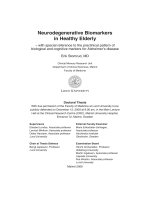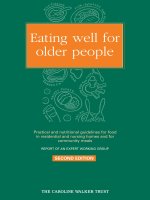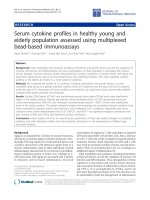healthy, thrifty meals
Bạn đang xem bản rút gọn của tài liệu. Xem và tải ngay bản đầy đủ của tài liệu tại đây (252.87 KB, 78 trang )
Recipes and Tips for
Healthy, Thrifty Meals
United States
Department of
Agriculture
Center for Nutrition
Policy and Promotion
Recipes and Tips for
Healthy, Thrifty Meals
FOREWORD
The essence of nutrition guidance is to provide the
public with the best information available to assist
them in making wise and nutritious food choices to
sustain life and good health. As public officials in the
U.S. Department of Agriculture, we are deeply
concerned that Americans not only have enough food
but also that the public has enough information to
know what food to purchase and how to prepare it.
While a healthy diet is the cornerstone to good
health, meeting that goal can be a challenge. That is
why we are delighted to offer this publication to the
public.
Recipes and Tips for Healthy, Thrifty Meals is
more than a cookbook. The book provides basic
cooking and food safety guidance. The menus
presented here conform to the recommendations
contained in the Dietary Guidelines for Americans
and the USDA Food Guide Pyramid. The 40 recipes
are quick, easy, tasty and economical.
We hope that you will find the recipes and other
information provided in this book useful. At the back
of the book is information on how to get more
nutrition information. If you have comments or
suggestions, let us hear from you.
Shirley R. Watkins Rajen S. Anand, Ph.D.
Under Secretary Executive Director
Food, Nutrition and Center for Nutrition
Consumer Services Policy and Promotion
1
3
TABLE OF CONTENTS
Introduction 4
Tips for healthy, thrifty meals 5
Some best buys for cost and nutrition 8
Tips for healthy cooking 10
Keep your family’s food safe 11
Menus for 2 weeks of meals 13
Recipes 18
Food lists for 2 weeks of meals 69
Recipe list 74
INTRODUCTION
How can you serve healthy meals on a limited
budget? It takes some time and planning, but you
and your family can eat better for less. This booklet
can help you save money as you prepare healthy
meals. It contains
• Tips for planning, shopping, and cooking healthy
meals on a tight budget
• Sample menus for 2 weeks for breakfast, lunch,
dinner, and snacks
• Recipes for healthy, thrifty meals
• Lists of the foods needed for each weekly menu
4
TIPS FOR HEALTHY,THRIFTY MEALS
WHY PLAN MEALS?
To help you and your family be healthier. When you
plan meals, you can make sure you include enough
foods from each food group. Pay special attention to
serving enough vegetables and fruits in family meals.
To help you balance meals. When you are serving a
food with a lot of fat or salt, you can plan lowfat or
low-salt foods to go with it. For example, ham is
high in salt. If you have ham for dinner, you also can
serve a salad or a vegetable that doesn’t need salt.
To save money. If you plan before you go food
shopping, you will know what you have on hand
and what you need. Also, shopping from a list helps
you avoid expensive “impulse” purchases.
To save time and effort. When you plan meals, you
have foods on hand and make fewer trips to the
grocery store. Planning also helps you make
good use of leftovers. This can cut your cooking time
and food costs.
TIPS FOR PLANNING
Build the main part of your meal around rice,
noodles, or other grains. Use small amounts of meat,
poultry, fish, or eggs.
• For example, make a casserole by mixing rice,
vegetables, and chicken. Or try Beef-Noodle
Casserole (p. 22) or Stir-Fried Pork and Vegetables
with Rice (p. 26).
Add variety to family meals. In addition to cooking
family favorites, try new, low-cost recipes or food
combinations.
• For example, if you usually serve mashed potatoes,
try Baked Crispy Potatoes (p. 49) or Potato Salad
(p. 58) for a change.
5
continued
Make meals easier to prepare by trying new ways
to cook foods.
• For example, try using a slow cooker or crock-pot
to cook stews or soups. They cook foods without
constant watching.
Use planned leftovers to save both time and money.
• For example, prepare a Beef Pot Roast (p. 21),
serve half of it, and freeze the remaining half to use
later. You also can freeze extra cooked meats and
vegetables for soups or stews.
Do “batch cooking” when your food budget and
time allow.
• For example, cook a large batch of Baked
Meatballs (p. 20) or Turkey Chili (p. 39), divide it
into family-size portions, and freeze some for meals
later in the month.
Plan snacks that give your family the nutrients
they need.
• For example, buy fresh fruits in season like apples
or peaches. Dried fruits like raisins or prunes, raw
vegetables, crackers, and whole wheat bread are
also good ideas for snacks.
TIPS FOR SHOPPING
Before you go shopping
• Make a list of all the foods you need. Do this
in your kitchen so you can check what you have
on hand.
• Look for specials in the newspaper ads for the
stores where you shop.
• Look for coupons for foods you plan to buy.
But remember, coupons save money only if you
need the product. Also, check if other brands
are on sale, too. They may cost even less than
the one with a coupon.
6
continued
While you shop
• When your food budget allows, buy extra low-
cost, nutritious foods like potatoes and frozen
orange juice concentrate. These foods keep well.
• Compare the cost of convenience foods with the
same foods made from scratch. “Convenience
foods” are products like fancy baked goods, frozen
meals, and vegetables with seasonings and sauces.
Most of these cost more than similar foods
prepared at home. Also, you can use less fat,
sugar, and salt in food you make at home.
• Try store brands. They usually cost less than name
brands, but they taste as good and generally have
the same nutritional value.
• Take time to compare fresh, frozen, and canned
foods to see which is cheapest. Buy what’s on
special and what’s in season.
• Prevent food waste. Buy only the amount that your
family will eat before the food spoils.
Using label and shelf information
• Read the Nutrition Facts label on packaged foods.
Compare the amount of fat, sodium, calories, and
other nutrients in similar products. This can help
you choose foods that have less fat, sodium or
calories, and more vitamins, minerals, and fiber.
• Use date information on packages—“sell by” and
“best if used by” dates—to help you choose the
freshest foods.
• Look for the unit price to compare similar foods.
It tells you the cost per ounce, pound, or pint, so
you’ll know which brand or size is the best buy.
Most stores show the unit price on a shelf sticker
just below the product.
7
8
SOME BEST BUYS FOR COST AND NUTRITION
BREADS AND GRAINS Look for bargains on day-old bread and bakery products.
Buy regular rice, oatmeal, and grits instead of the instant and
flavored types.
Try whole-grain bread and brown rice to add nutrients and variety
to family meals.
VEGETABLES AND SALADS Look for large bags of frozen vegetables. They may be bargains and you can
cook just the amount you need, close the bag tightly, and put the rest back in
the freezer.
Foods at salad bars can be costly. Some food items—lettuce, cabbage, onions,
and carrots—usually cost less in the produce section of the store than at the
salad bar. But if you need only a small amount of a vegetable, buying at the
salad bar can save money if it reduces the amount you waste.
FRUITS Buy fresh fruits in season, when they generally cost less.
continued
MILK Nonfat dry milk is the least expensive way to buy milk. When using it as a
beverage, mix it several hours ahead and refrigerate so it can get cold before
drinking.
Buy fresh milk in large containers (gallon or 1/2 gallon). These generally cost
less than quarts.
Buy fat-free or lowfat milk to cut the amount of fat in your family’s meals.
Note that children under 2 years of age should be given only whole milk.
MEAT AND POULTRY Look for specials at the meat counter. Buying cuts of meat on sale can mean
big savings for you.
Buy chuck or bottom round roast instead of sirloin. These cuts have less fat
and cost less. They need to be covered during cooking and cooked longer to
make the meat tender.
Buy whole chickens and cut them into serving size pieces yourself.
DRY BEANS AND PEAS Use these sometimes instead of meat, poultry, or fish. They cost less and provide
many of the same nutrients. They are also lower in fat.
BULK FOODS Buy bulk foods when they are available. They can be lower in price than similar
foods sold in packages. Also, you can buy just the amount you need.
9
TIPS FOR HEALTHY COOKING
• Go easy on fat, sugar, and salt in preparing foods.
For example, make Oven Crispy Chicken (p. 37)
instead of fried chicken or make Baked Cod with
Cheese (p. 28) instead of fried fish. You don’t have
to leave out all the fat, sugar, or salt—just limit the
amount you use.
• Flavor foods with herbs, spices, and other lowfat
seasonings instead of using rich sauces and gravy.
Look for ideas about what seasonings to use in
some of the recipes in this booklet, like Baked
Meatballs (p. 20), Baked Spicy Fish (p. 29), and
Turkey Chili (p. 39).
• Make homemade desserts sometimes to save
money and serve additional healthy foods to
the family. For example, try a fruit crisp, like
Peach-Apple Crisp (p. 65), or a pudding like
Rice Pudding (p. 67).
• Remove skin from poultry before cooking to lower
the fat content. For example, try Baked Chicken
Nuggets (p. 34), Chicken and Vegetables (p. 36),
or Oven Crispy Chicken (p. 37).
• Always follow food safety rules in the kitchen
to make sure that the food you prepare for your
family is safe. See the next page.
10
KEEP YOUR FAMILY’S FOOD SAFE
Clean—wash hands and surfaces often:
• Always wash hands with soap and warm running
water before handling food.
• Always wash cutting boards, knives, utensils,
dishes, and countertops used to cut meat with
soapy, hot water right away—before you use them
for other foods.
• Consider using paper towels to clean up kitchen
surfaces. If you use cloth towels, dishcloths, or
sponges, wash them often, and every time they
have touched raw meat, poultry, or seafood juices.
Use hot soapy water or the hot water cycle of the
washing machine.
Separate—don’t cross contaminate:
• Store raw meat, chicken, turkey, and seafood in
a sealed, wrapped container in the refrigerator.
• Keep raw meat, chicken, turkey, and seafood away
from foods that will not be cooked and foods that
are already cooked.
• Never place cooked food on a plate or cutting
board that previously held raw meat, chicken,
turkey, or seafood.
Cook—cook to proper temperatures:
• Use a food thermometer to make sure meats,
chicken, turkey, fish, and casseroles are cooked to
a safe internal temperature.
• Cook roasts and steaks to at least 145° F.
• Cook ground meat to at least 160° F.
• Cook whole chicken or turkey to 180° F.
• Cook eggs until the yolk and white are firm, not
runny. Don’t use recipes in which eggs remain raw
or only partially cooked.
• Cook fish until it flakes easily with a fork.
11
continued
Chill—refrigerate promptly:
• Thaw frozen foods in the refrigerator, not on the
kitchen counter. You can also thaw foods under
cold water, changing the water every 30 minutes.
Or, use a microwave oven.
• Refrigerate or freeze leftover foods right away.
Meat, chicken, turkey, seafood, and egg dishes
should not sit out at room temperature for more
than 2 hours.
• Divide large amounts of leftovers into small,
shallow containers for quick cooling in the
refrigerator.
• Keep your refrigerator at 40°F or below. Don’t
pack the refrigerator. Cool air needs to circulate
to keep food safe.
12
MENUS
These menus are not rigid guides and can be used in
any order. They give suggestions for thrifty food
choices and healthy ways to prepare foods. The foods
used in the menus are a variety of commonly eaten
meats, milk products, vegetables, fruits, grain
products, and mixed dishes.
The daily menus show how you can combine a
larger amount of less expensive foods, such as dry
beans and grain products, with a smaller amount of
meats, poultry, and fish. Some convenience or ready-
to-eat food items are included in the menus.
However, many of the foods are prepared from
“scratch” to keep cost as low as possible.
These menus and recipes are designed for a healthy
four-person family. The amount listed after each food
item is the
total amount for a family with two adults
and two children 6 to 11 years old.
13
WEEK 1. MENUS FOR A FAMILY OF FOUR
14
BREAKFAST
Orange juice (3 c)
Ready-to-eat
cereal (3 c flakes)
Toasted English
muffin (4)
1% lowfat milk (2 c)
Orange juice (3 c)
Banana (4)
Bagel (4)
Margarine (4 tsp)
1% lowfat milk (2 c)
Orange juice (3 c)
Cooked rice cereal
Bagel (4)
Margarine (4 tsp)
Orange juice (3 c)
Scrambled eggs (4)
Hash brown
potatoes (2 c)
1% lowfat milk (2 c)
Orange juice (3 c)
Ready-to-eat cereal
(3 c flakes)
English muffin (4)
Margarine (4 tsp)
1% lowfat milk (2 c)
Orange juice (3 c)
Baked French toast
Cinnamon sugar
topping (4 tsp)
1% lowfat milk (2 c)
Orange juice (3 c)
Baked potato cakes
White toast
(4 slices)
1% lowfat milk (2 c)
LUNCH
Turkey patties
Hamburger bun (4)
Orange juice (3 c)
Coleslaw (2 c)
1% lowfat milk (2 c)
Crispy chicken
Potato salad
Orange gelatin
salad
Peaches, canned (1 c)
Rice pudding
Turkey chili
Macaroni (2 c)
Peach-apple crisp
1% lowfat milk (2 c)
Orange juice (3 c)
Turkey ham (11 oz,
2 tbsp salad
dressing)
sandwiches (4)
Baked beans
Banana slices (2 c)
Oatmeal cookies
Orange juice (3 c)
1% lowfat milk (2 c)
Potato soup
Snack crackers,
low salt (5 each)
Tuna pasta salad
Orange slices (2 c)
Oatmeal cookies
1% lowfat milk (2 c)
Potato soup
Snack crackers,
low salt (5 each)
Apple orange slices
(2 apples,
2 oranges) (2 c)
Rice pudding
1% lowfat milk (2 c)
Baked fish (12 oz,
4 tbsp salad
dressing)
sandwiches (4)
Crispy potatoes
Macaroni salad
Melon (1-1/3 c)
Orange juice (3 c)
1% lowfat milk (2 c)
MONDAY TUESDAY WEDNESDAY THURSDAY FRIDAY SATURDAY SUNDAY
continued
15
DINNER
Beef-noodle
casserole
Lima beans (2 c)
Banana orange
salad (2 bananas,
2 oranges) (2 c)
1% lowfat milk (2 c)
Turkey stir fry
Steamed rice (3 c)
White bread
(4 slices)
Peach-apple crisp
1% lowfat milk (2 c)
Baked cod
w/cheese
Scalloped potatoes
Spinach (1-1/3 c)
Margarine (4 tsp)
Chocolate pudding
(2 c)
Beef pot roast
Noodles (4 c)
Peas and carrots (1 c)
Orange slices (2 c)
Biscuits (8)
Margarine (4 tsp)
Rice pudding
1% lowfat milk (2 c)
Beef pot roast (12 oz)
Noodles (4 c)
Green beans
(1-1/3 c)
Leaf lettuce
(1-1/3 c)
Salad dressing
(4 tbsp)
Rice pudding
1% lowfat milk (2 c)
Saucy beef pasta
White bread (4)
Canned pears (2 c)
Orange juice (3 c)
1% lowfat milk (2 c)
Turkey-cabbage
casserole (8 c)
Orange slices (2 c)
White bread
(2 slices)
Chickpea dip
1% lowfat milk (2 c)
SNACK
White bread
(4 slices)
Chickpea dip
Lemonade (4 c)
Orange juice (3 c)
Crispy potatoes Lemonade (4 c) Biscuits (8)
Margarine (4 tsp)
Lemonade (4 c)
Lemonade (4 c)
MONDAY TUESDAY WEDNESDAY THURSDAY FRIDAY SATURDAY SUNDAY
Recipes are provided for foods in bold typeface.
16
WEEK I1. MENUS FOR A FAMILY OF FOUR
BREAKFAST
Orange juice (3 c)
Hash brown
potatoes (2 c)
Biscuits (8)
Margarine (4 tsp)
Jelly (8 tbsp)
Orange juice (3 c)
Ready-to-eat
cereal
(3 c toasted oats)
White toast
(4 slices)
Margarine (8tsp)
1% lowfat milk (2c)
Orange juice (3 c)
Bananas (1/2 c)
Ready-to-eat
cereal
(3 c toasted oats)
White toast
(4 slices)
Jelly (8 tbsp)
1% lowfat milk (2 c)
Orange juice (3 c)
Cooked rice cereal
White toast
(4 slices)
Margarine (8 tsp)
1% lowfat milk (2 c)
Orange juice (3 c)
Ready-to-eat
cereal
(3 c toasted oats)
White toast
(4 slices)
Margarine (4 tsp)
1% lowfat milk (2 c)
Orange juice (3 c)
Scrambled eggs
(2 c)
Turkey ham (11 oz)
Bagels (4)
1% lowfat milk (2 c)
Orange juice (3 c)
Melon (1-1/3 c)
Pancakes (12)
Pancake syrup
(8 tbsp)
1% lowfat milk (2 c)
LUNCH
Chicken and
vegetables
Scalloped potatoes
Grapes (12 oz)
Whole wheat bread
(4 slices)
Margarine (4 tsp)
Peach cake
1% lowfat milk (2 c)
Pizza meat loaf
Noodles (4 c)
Margarine (8 tsp)
Orange slices (2 c)
1% lowfat milk (2 c)
Tuna macaroni
salad
White bread
(4 slices)
Margarine (4 tsp)
Apple slices (2 c)
1% lowfat milk (2 c)
Cocoa drink mix
(2 oz)
Hamburger (12 oz)
sandwiches (4)
Ranch beans
Orange gelatin
salad
Banana slices (1/2 c)
1% lowfat milk (2 c)
Baked chicken
nuggets
Shoestring potatoes
Macaroni (5 c)
Margarine (4 tsp)
Orange gelatin
salad
1% lowfat milk (2 c)
Chicken noodle
soup
Biscuits (8)
Canned peaches
(2 c)
Orange juice (3 c)
1% lowfat milk (2 c)
Cocoa drink mix
(2 oz)
Meatball (12)
sandwiches (4)
Grapes (12 oz)
Sugar cookies
1% lowfat milk (2 c)
Orange juice (3 c)
MONDAY TUESDAY WEDNESDAY THURSDAY FRIDAY SATURDAY SUNDAY
continued
17
DINNER
Southwestern
salad
Steamed rice (6 c)
Apple orange
salad (2 apples,
2 oranges) (2 c)
Margarine (4 tsp)
1% lowfat milk (2 c)
Spanish baked fish
Steamed rice (6 c)
Peas (1-1/3 c)
Whole wheat
bread (4 slices)
Margarine (8 tsp)
Peach cake
1% lowfat milk (2 c)
Stir-fried pork and
vegetables with
rice
Dinner rolls (4)
Margarine (4 tsp)
Mandarin oranges
(2 c)
1% lowfat milk (2 c)
Baked chicken
(10 oz)
Mash potatoes
(6 c)
Green beans
(1-1/2 c)
White bread
(4 slices)
Margarine
(5-1/3 tbsp)
Orange slices (2 c)
1% lowfat milk (2 c)
Baked spicy fish
Noodles (4 c)
Peas and carrots
(10 oz)
White bread
(4 slices)
Margarine (8 tsp)
Chocolate rice
pudding
1% lowfat milk (2 c)
Baked meatballs
Spaghetti and
sauce (5 c)
Leaf lettuce (2 c)
Salad dressing
(4 tbsp)
French bread
(4 slices)
1% lowfat milk (2 c)
Cheese-stuffed
potatoes
Macaroni (5 c)
Peas (1-1/3 c)
Margarine (8 tsp)
Orange slices (2 c)
1% lowfat milk (2 c)
SNACK
Popcorn (6 c)
Shoestring
potatoes
Fruit drink (4 c)
Popcorn (6 c)
Orange juice (3 c)
Chocolate rice
pudding
Baked French fries
(11 oz)
Fruit drink (4 c)
Ice milk fudgesicle
(4)
Popcorn (6 c)
Fruit drink (4 c)
MONDAY TUESDAY WEDNESDAY THURSDAY FRIDAY SATURDAY SUNDAY
Recipes are provided for foods in bold typeface.
RECIPES
The following 40 recipes were developed for the
2 sample weekly menus. Many of them combine
larger amounts of less expensive foods with smaller
amounts of moderately priced foods. They also show
how you can prepare tasty, healthy meals with less
fat, sugar, and salt. Serve these recipes along with the
other foods listed in each menu. You can also serve
them in meals with other foods your family likes.
Each recipe lists
• ingredients and preparation instructions,
• the number of servings it will make,
• the size of each serving,
• the amount of preparation time,
• the amount of cooking time, and
• the calories, total fat, saturated fat, cholesterol,
and sodium in a serving.
18
MAIN DISHES
BEEF AND PORK
BAKED MEATBALLS
4 Servings, about 3 meatballs each, plus 4 servings
for another meal
Onions, minced 1/4 cup
Vegetable oil 1 tablespoon
Lean ground beef 2 pounds
Eggs 2
Bread crumb 3/4 cup
Whole milk 1/2 cup
Salt 1/8 teaspoon
Pepper 1/2 teaspoon
Onion powder 2 teaspoons
Garlic powder 1/2 teaspoon
PREPARATION TIME: 15 MINUTES
COOKING TIME: 10 TO 12 MINUTES
1. Preheat oven 400˚ F. Grease baking sheet lightly
with oil.
2. Add 1 tablespoon oil and onions to small skillet.
Cook over medium heat, until tender, about
3 minutes.
3. Mix remaining ingredients together in bowl; add
onions. Mix until blended, using a large serving
spoon.
4. Shape beef mixture into 1- to 2-inch meatballs;
place on baking sheet.
5. Bake until thoroughly cooked, about 10 to
12 minutes.
Note: Serve with spaghetti sauce and in the
meatball sandwich.
PER SERVING:
Calories 345
Total fat 21 grams
Saturated fat 7 grams
Cholesterol 142 milligrams
Sodium 224 milligrams
20
BEEF POT ROAST
4 Servings, about 3 ounces beef each, plus 4
servings for another meal
Onion, chopped 1/2 cup
Water 2 tablespoons
Beef chuck roast, boneless 2-1/2 pounds
Hot water 2 cups
Beef bouillon 1 cube
Orange juice 2 tablespoons
Ground allspice 1/4 teaspoon
Pepper 1/8 teaspoon
PREPARATION TIME: 20 MINUTES
COOKING TIME: 2 HOURS
1. Simmer onion until tender in 2 tablespoons
water in heavy, deep skillet.
2. Add roast to skillet; brown on sides.
3. Combine beef bouillon cube with 2 cups hot
water; stir until dissolved.
4. Combine orange juice, allspice, pepper, and beef
broth. Pour over meat. Cover and simmer,
about 2 hours.
PER SERVING:
Calories 220
Total fat 9 grams
Saturated fat 3 grams
Cholesterol 91 milligrams
Sodium 264 milligrams
21
BEEF-NOODLE CASSEROLE
4 Servings, about 2 cups each
Lean ground beef 1 pound
Onions, chopped finely 1/2 cup
Boiling water 3 quarts
Noodles, yolk-free, enriched,
uncooked 2-3/4 cups
Tomato soup, condensed 1 10-3/4-ounce can
Water 1-1/4 cups
Pepper 1/8 teaspoon
Bread crumbs 1 cup
PREPARATION TIME: 20 MINUTES
COOKING TIME: 30 MINUTES
1. Brown beef and onions in hot skillet; drain.
2. Place water in large saucepan; bring to rolling
boil. Cook noodles in boiling water for 10
minutes; drain and set aside.
3. Combine soup, water, and pepper. Stir into
cooked meat. Add cooked noodles to meat
mixture. Stir gently to avoid tearing the noodles.
4. Spoon beef-noodle mixture into 9- by 13-inch
baking pan. Sprinkle bread crumbs over
beef-noodle mixture.
5. Bake, uncovered, at 300˚ F, about 30 minutes.
PER SERVING:
Calories 595
Total fat 18 grams
Saturated fat 6 grams
Cholesterol 86 milligrams
Sodium 575 milligrams
22
PIZZA MEAT LOAF
4 Servings, about 1/4 loaf each
Ground turkey 1 pound
Spaghetti sauce 3/4 cup
Mozzarella cheese, part-skim 1/4 cup
Green peppers, chopped 1/2 cup
Onion, minced 1/4 cup
PREPARATION TIME: 15 MINUTES
CONVENTIONAL COOKING TIME: 20 MINUTES
MICROWAVE COOKING TIME: 8 MINUTES
1. Lightly grease 9-inch pie plate with vegetable
oil. Pat turkey into pie plate.
CONVENTIONAL METHOD
1. Place turkey in 350˚ F oven; bake until turkey
no longer remains pink, about 17 to 20 minutes.
MICROWAVE METHOD
1. Cover turkey with waxed paper.
2. Cook on high; rotate plate 1/4 turn after 3
minutes.
3. Cook until turkey no longer remains pink, about
5 more minutes. Drain.
TO COMPLETE COOKING
1. Top baked turkey with spaghetti sauce, cheese,
and vegetables.
2. Return turkey to either the conventional oven or
the microwave oven and heat until cheese is
melted, about 1 to 2 minutes.
PER SERVING:
Calories 255
Total fat 14 grams
Saturated fat 4 grams
Cholesterol 88 milligrams
Sodium 376 milligrams
23
SAUCY BEEF PASTA
4 Servings, about 1-1/2 cups each
Water 1/2 cup
Green beans, frozen 1/2 10-ounce package
Onions, minced 1/2 cup
Lean ground beef 1 pound + 6 ounces
Noodles, yolk-free,
enriched, uncooked 6-3/4 cups
Cold water 2 cups
Beef bouillon 2 cubes
Flour 1/3 cup
Pepper 1/4 teaspoon
Dry parsley flakes 1 teaspoon
Garlic powder 1/2 teaspoon
Onion powder 1 teaspoon
PREPARATION TIME: 25 MINUTES
COOKING TIME:ABOUT 35 MINUTES
1. Place 1/2 cup of water in saucepan. Cover and bring
to boil. Add green beans, lower heat, and simmer until
tender, about 5 minutes. Drain.
2. Place onions and ground beef in skillet. Cook over
medium heat; stir occasionally. Cook until beef no longer
remains pink, about 5 to 10 minutes. Drain fat off.
3. Cook noodles according to package instructions. Drain.
4. Combine cold water and flour; stir until smooth. Add
flour mixture and beef bouillon cubes to ground beef.
Cook, stirring frequently until mixture has thickened
and bouillon cubes have dissolved, about 4 minutes.
5. Add cooked green beans, cooked noodles, pepper,
parsley flakes, garlic powder, and onion powder
to ground beef mixture; stir to combine.
6. Place beef mixture in 8- by 12-inch baking pan; cover and bake
in 350˚ F oven until thoroughly heated, about 15 minutes.
PER SERVING:
Calories 605
Total fat 22 grams
Saturated fat 8 grams
Cholesterol 120 milligrams
Sodium 405 milligrams
24
SOUTHWESTERN SALAD
4 Servings, about 1/2 cup beef mixture, 1/2 cup
lettuce and cheese mixture each
Onions, chopped 1/2 cup
Lean ground beef 1 pound
Chili powder 1 tablespoon
Dry oregano 2 teaspoons
Ground cumin 1/2 teaspoon
Canned kidney beans, red, drained 1 cup
Canned chickpeas, drained 1 15-ounce can
Tomato, diced 1 medium
Lettuce 2 cups
Cheddar cheese 1/2 cup
PREPARATION TIME: 15 MINUTES
COOKING TIME: 10 TO 15 MINUTES
1. Cook ground beef and onions in a large skillet
until the beef no longer remains pink. Drain.
2. Stir chili powder, oregano, and cumin into beef
mixture; cook for 1 minute.
3. Add beans, chickpeas, and tomatoes. Mix gently
to combine.
4. Combine lettuce and cheese in large serving
bowl. Portion lettuce and cheese onto 4 plates.
Add 1 cup of beef mixture on top of lettuce and
cheese.
Note: Garbanzo bean is another name for
chickpea.
PER SERVING:
Calories 485
Total fat 22 grams
Saturated fat 9 grams
Cholesterol 98 milligrams
Sodium 411 milligrams
25









